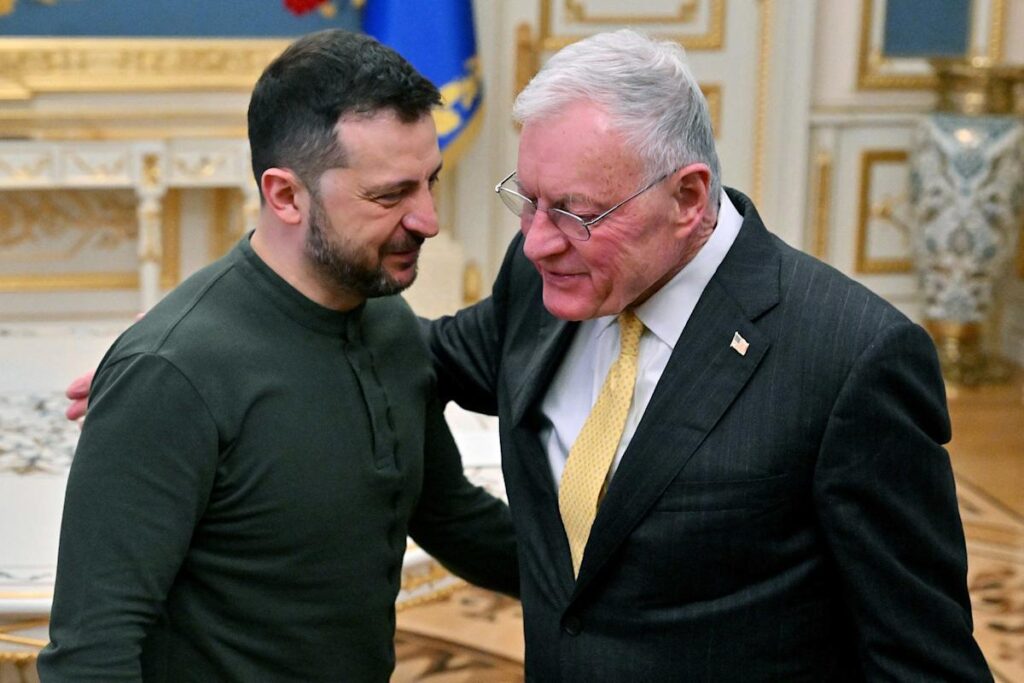President Donald Trump’s special envoy to Ukraine appeared to suggest that the country could be divided like Berlin after World War II, as another of his envoys held long talks with Russian President Vladimir Putin.
Urged by Trump on Truth Social to “get moving” on a ceasefire to end the “terrible and senseless war,” Putin spoke for four hours with Steve Witkoff, the U.S. special envoy leading talks with the Kremlin, in the the Russian city of St. Petersburg on Friday.
Neither Moscow or Witkoff, who later flew to Oman for talks with Iran, commented on what was said at the meeting, which did not include representatives from Ukraine, despite President Volodymyr Zelenskky repeatedly insisting that his country should be involved in the talks.
Zelenskyy, who has firmly rejected any territorial concessions to Russia, will likely have been disappointed to read comments from Trump’s special envoy to Ukraine, retired Lt. Gen. Keith Kellogg, who told The Times of London that Ukraine could “look like what happened with Berlin” after World War II.
He said British and French troops could serve as a “reassurance force” west of the Dnieper River which bisects parts of the north and east of Ukraine before flowing out into the Black Sea in the South.
Russian forces could remained in the parts of the east which they already occupy, separated by Ukrainian troops and a demilitarized zone, he said.
Kellogg later pushed back, claiming on social media that the article had misrepresented him.
“I was speaking of a post-ceasefire resiliency force in support of Ukraine’s sovereignty,” he posted on X. “In discussions of partitioning, I was referencing areas or zones of responsibility for an allied force (without U.S. troops). I was NOT referring to a partitioning of Ukraine.”
There are clear differences between Kellogg’s proposal and the division of Berlin and Germany after WWII. While Germany surrendered to invading armies, Ukraine would, under Kellogg’s idea, invite allies into its western territory — without conceding further land to Russia.
Still, the reference to “zones” is likely to have raised alarms in Kyiv, reinforcing fears that U.S. negotiations might acknowledge Russia’s de facto control of occupied Ukrainian territory.
Ukraine has repeatedly rejected any ceasefire or peace deal involving the ceding of land. Meanwhile Russia’s Foreign Minister Sergey Lavrov said in March that the Kremlin would not accept peacekeeping troops from any NATO country “under any condition.”
This isn’t the first time suggestions have surfaced that a ceasefire will involve Ukraine ceding territory to Russia.
In February, Defense Secretary Pete Hegseth called it “unrealistic” to expect a return to Ukraine’s pre-2014 borders—when Russia annexed Crimea and backed separatists in the east. Hegseth’s remarks underlined a sharp shift in policy — while President Biden pursued full Ukrainian victory, Trump has emphasized ending the war swiftly.
As Witkoff arrived in Russia, Trump posted on Truth Social: “Russia has to get moving. Too many people ere DYING, thousands a week, in a terrible and senseless war — a war that should have never happened, and wouldn’t have happened, if I were president.”
Meanwhile, on Friday night, Russia launched a large-scale drone attack across Ukraine. According to Ukrainian officials, 56 of 88 drones were shot down, and 24 more were redirected using electronic warfare.
Kyiv mayor Vitali Klitchko said that three people were injured in the capital as a result of the drone attacks. One more person was wounded in the city of Kharkiv in the northeast, Kharkiv’s mayor, Ihor Terekhov, said.
This article was originally published on NBCNews.com
Read the full article here
